
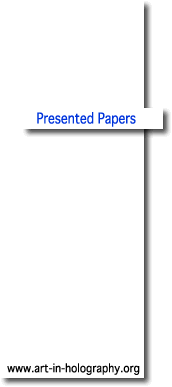

ON COLLECTING HOLOGRAPHY
I have been invited here to talk about my collection of holograms and given twenty minutes to do it in. If the collection was all here and I could show it to you I could quite happily go on all day so under the circumstances the best I can do is to try and give you a taste of what the collection contains and to try and explain what it means to me.
Like most of the other collectors of holography I have met I have a professional involvement with the medium. In 1978, just after the highly successful Light Fantastic exhibitions at the Royal Academy in London, I was invited to join a group of enthusiasts in setting up a hologram gallery - The Hologram Place - and a production company - SEE 3 Holograms.
The Hologram Place, which ran for one
year, showed lots of multiplex holograms and a selection of work
by mainly American artists and sold loads of dichromate pendants.
Since we never sold any of the artworks I ended up owning quite
a few nice early pieces such as Steve Benton's "Rind",
"Shadowbox" by Dan Schweitzer, Bill Molteni's "Portrait
of Susan Houd" and "Newton's Apples" and "Egg
& Jewel" by Randy James .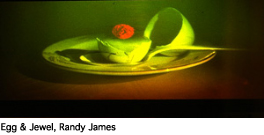
When the gallery closed due to lack of business (there wasn't actually a lot to sell in those days apart from pendants) SEE 3 carried on with the business of producing commercial displays and I had the basis of a collection.
Over the next few years I was more
involved in business than art but one of the pieces I bought
was "Homage to Louis Comfort Tiffany" by Ruben Nunez
which is in the exhibition here today. Ruben was in London for
a few days and I went to meet him at his hotel. We went up to
his room and he 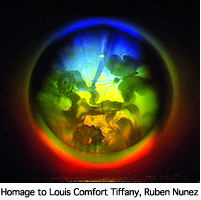 produced
a couple of holograms from his suitcase rather as if he was unveiling
the Ark of the Covenant. Even by the light of his bedside lamp
I could tell they were exquisite things and I experienced that
sensation which is now familiar - a kind of hollowness in the
pit of my stomach and an increased production of saliva - which
made me realise that I was going to have to part with a substantial
amount of cash. (It sounds rather disgusting,doesn't it, but
it's not an unpleasant sensation. Actually, to be honest it is
Lust)).
produced
a couple of holograms from his suitcase rather as if he was unveiling
the Ark of the Covenant. Even by the light of his bedside lamp
I could tell they were exquisite things and I experienced that
sensation which is now familiar - a kind of hollowness in the
pit of my stomach and an increased production of saliva - which
made me realise that I was going to have to part with a substantial
amount of cash. (It sounds rather disgusting,doesn't it, but
it's not an unpleasant sensation. Actually, to be honest it is
Lust)).
Homage to Tiffany depicts a glowing orb of light containing amorphous organic shapes - it has a mandala-like quality and like many of my favourite holograms can enduce a trance like state if you stare at it long enough. For many years it hung on the landing of my house and at the end of the day when I turned on the houselights I could stand in front of it and trance out to my heart's content.
Another piece acquired around that time was Ken Harris's "Lightman" which has a similar mesmerising radiance and I remain extremely fond of it. Ken produced an interesting body of work before going into commercial holography and I have a few other nice examples in my collection.
England in the early '80s was heavily
influenced by Nick Phillips' style of reflection holography and
has continued to be strong in documentary work. My collection
contains commercial and display work as well as art pieces and
the following are a few good examples: 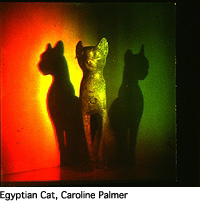 Digital
by Nick Phillips, Lizards by Dominic Welby, Buddha & Egyptian
Cat by Caroline Palmer, Charles Ist's helmet & Henry VIIIths
helmet by Rob Munday, The mask of Tutankhamen by Jeff Blythe
-another influential British holographer in terms of technique.
Digital
by Nick Phillips, Lizards by Dominic Welby, Buddha & Egyptian
Cat by Caroline Palmer, Charles Ist's helmet & Henry VIIIths
helmet by Rob Munday, The mask of Tutankhamen by Jeff Blythe
-another influential British holographer in terms of technique.
Here is a Self Portrait by Edwina Orr who taught a lot of British holographers around that time. It illustrates well her powerful personality and technical strength.
Edwina's piece "Sketches" -a delightful little animation - is an early gem and I was pleased to acquire a couple of variations when I bought Eve Ritscher's collection a few years ago. Eve is another force of nature who organised the important Light Dimensions shows at the RPS in Bath and at the Science Museum and the acquisition of her collection provided me with some other treasures such as the Portrait of Dennis Gabor and some pieces of the experimental holographic movies made by the NIKFI Institute in the USSR.
When I finally sold SEE 3 and started
to collect holographic art more seriously, the collection began
to serve two functions. Firstly it was an attempt to document
trends in holography and the development of various artists styles
and secondly it became the record of my friendship with those
artists. I always like to buy work from people I know and as
my acquaintanceship with them has extended over the years, the
friendships have grown. 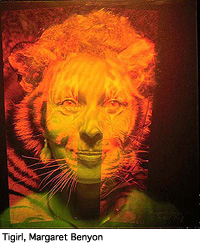 Living in England as I do has meant that my collection contains
more English work than anything else and I am particularly proud
of my holdings of work by and friendship with Margaret Benyon.
"Tigirl" was the first piece of hers I bought and it
was and remains quite irresistible. I subsequently acquired "Split
Benedict" after showing it in an exhibitIon of Four British
Holographers which I put on in 1992 as I could not bear to let
her have it back. "Portrait of Richard Hamilton"and
"Painted Stephan" were bought over the next couple
of years and I have recently acquired "Wrapped Flowers"
after seeing it again in her recent Cornucopia exhibition in
Bournemouth. I wish I had known her at the beginning of her career
as I would love to own some of her earlier work too.
Living in England as I do has meant that my collection contains
more English work than anything else and I am particularly proud
of my holdings of work by and friendship with Margaret Benyon.
"Tigirl" was the first piece of hers I bought and it
was and remains quite irresistible. I subsequently acquired "Split
Benedict" after showing it in an exhibitIon of Four British
Holographers which I put on in 1992 as I could not bear to let
her have it back. "Portrait of Richard Hamilton"and
"Painted Stephan" were bought over the next couple
of years and I have recently acquired "Wrapped Flowers"
after seeing it again in her recent Cornucopia exhibition in
Bournemouth. I wish I had known her at the beginning of her career
as I would love to own some of her earlier work too.
Patrick Boyd is an artist whose work
I first saw when he was at the Royal College of Art and who I
immediately recognised as having a very fresh and original approach
to holography. His earlier works such as "Beano" and
"Breakfast" showed his interest in style and fashion
but his subsequent work with stereograms - taking images out
in the real world as opposed to the confines of the holography
lab - have led him in an even more interesting direction. 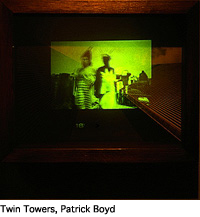 "Twin Towers"
, made when Patrick was at the Museum of holography in New york
represents a linkbetween the two periods. "Jackson Goes
to Manhattan" & "Atlantic City" are two other
works from that period. Patrick & I have worked on projects
together and we remained in constant contact even when he was
living in Japan. From having initially been an artist whose work
I admired he has become one of my best mates.
"Twin Towers"
, made when Patrick was at the Museum of holography in New york
represents a linkbetween the two periods. "Jackson Goes
to Manhattan" & "Atlantic City" are two other
works from that period. Patrick & I have worked on projects
together and we remained in constant contact even when he was
living in Japan. From having initially been an artist whose work
I admired he has become one of my best mates.
Another good friend is David Pizzanelli
with whom I worked at SEE 3 for ten years and who has been a
great influence and source of encouragement in my collecting
endeavours. He introduced me to 19th century stereo photography,
the collection of which is another subject on which I could bore
for Britain. In the last couple of years at SEE 3 David began
to develop his own work and went on to take a PhD at the Royal
College. I was present at the conception and birth of his Muybridge
series and have exhibited examples in several shows I have been
associated with. "Good Morning", "Mother &
Child" and "Arabesque". 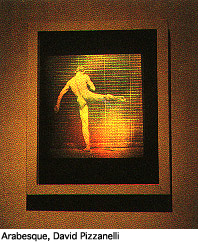 David
has done a lot of work with found images and his degree show
contained a series derived from a sex education video. When I
commented "Those are rather jolly" he did me the honour
of naming them the "Jolly Series".
David
has done a lot of work with found images and his degree show
contained a series derived from a sex education video. When I
commented "Those are rather jolly" he did me the honour
of naming them the "Jolly Series".
Martin Richardson is another British
artist I have known and loved for many years and his work is
well represented in my collection. Occasionally he would need
to buy some new equipment and would call up and offer me a deal.
Like most collectors I find that irresistible. Sometimes the
opportunity to buy work at a knockdown price is the best incentive
for adding to one's collection that exists. Not a very pure motive
perhaps but sometimes it just happens that way. 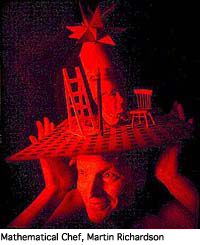 These
are a few other pieces of his in my collection "Freedom
is a Word III", "Frenzy", & "Mathematical
Chef". The last piece was sadly broken when I lent it back
to him for an exhibition last year but he promises to make me
another copy.
These
are a few other pieces of his in my collection "Freedom
is a Word III", "Frenzy", & "Mathematical
Chef". The last piece was sadly broken when I lent it back
to him for an exhibition last year but he promises to make me
another copy.
Buying work at a degree show is always a pleasure because it is very fresh and one's response to it is consequently direct. It is also nice to be able to encourage artists at a crucial stage in their careers. I bought "Elevator" from Caroline Palmer after seeing it at the Royal College and later bought "Sakti Cluster" and "Diamonds and Stripes" to keep it company. When Caroline went to the College she started todo less of her superb work making holographic recordings of artifacts and began to explore geometry , light and colour. As ever her work was thoughtful, immaculately executed and elegantly displayed.
Pearl John's "Shopping" was another degree show find and in its depiction of a succession of shop window views that took her fancy on the journey into college I was reminded in a way of the process of collecting.
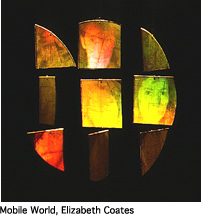 Liz
Coates's "Mobile World" was the star piece of her year
at the RCA and enhanced my house for several years. It contains
portraits of several of her contemporaries at the college which
adds another element to its interest. A document of an era as
well as a thing of beauty.
Liz
Coates's "Mobile World" was the star piece of her year
at the RCA and enhanced my house for several years. It contains
portraits of several of her contemporaries at the college which
adds another element to its interest. A document of an era as
well as a thing of beauty.
 Jon
Mitton is another RCA star whose originality was immediately
visible.
Jon
Mitton is another RCA star whose originality was immediately
visible.
His animation work was humourous and sexy - a great combination.
"You will Obey" and "Testosterone" I love
his approach and supported his Hardcore Holography exhibition
which was closed down by the Liverpool vice squad for the most
absurd reasons. I am delighted to be showing one of his Hardcore
works here and trust that censorship will not apply in Nottingham.
"Landscape" Jeffrey Robb was incredibly prolific and versatile while at the college, working his way through a wide repertoire of styles. I gave him a one man show entitled "Landscapes and Metamorphoses" in 1993 and remember it as one of my favourites. It illustrated two aspects of his work - one dealing with an almost painterly approach to the rendering of landscape in holography and the other his selection and manipulation of found images using the stereogram process in combination with computer techniques. "My Great Aunt" (SLIDE 50) "Water Droplet" These two images were not in that show but are other aspects of his stereogram work.
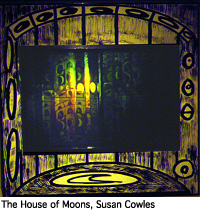 "The
House of Moons - A Stage for the Chymical Theatre"
"The
House of Moons - A Stage for the Chymical Theatre"
Finally from the RCA days, Susan Cowles, a painter drawn to holography
for its capacity to add depth to her work and by its alchemical
associations. Her work has layers of meaning as well as layers
of imagery.
As I said, the collection is predominantly British but there are Americans in it too. "Round Rocks". I bought a few pieces from John Kaufman when I found he had made a series in larger, less expensive editions than usual. I had always admired his work but never felt I could afford it and also,as he lives in California, I didn't get to see it that often so the temptation was less strong. The pieces I bought were as beautifully made as everything he does and as I don't think the editions have reached high numbers anyway I am delighted with what seems to me to be a bargain. "Flying Stone". Similarly Harriet Casdin-Silver's work seemed unlikely to be within my price range, but a few years ago she produced this exquisite little piece - a stereogram of a modern day "Venus of Willendorf" -displayed as a metal shim. It was like a 20th century Daguerreotype, tiny and precious. I bought it and I treasure it.
The final slide is of Eduardo Kac's "Ad Huc", which I bought from him at the last Lake Forest conference. Eduardo makes holopoetry and the words that appeared in this piece spoke to me personally at that time - Ever , Never, Whenever- in which ever order you choose to read them. Sometimes a work of art is particularly appropriate to the moment and that is what makes you want to buy it.
What other reasons are there? Predominantly the chance to make a collection of a developing artform. It has been my luck to be in the right place at the right time and to have discovered holography as it was growing up. To me it has represented the most wonderful opportunity - to be involved with a medium that appeals to me on so many levels. It can hypnotise and entrance me, amuse me , appeal to my intellect and turn me on. I appear to have described the perfect lover. But the difference is that as a collector of holography I want to share my loved one with the world. I don't want to sound pompous but I think that that is a collector's duty, especially if you think you have happened across something rare and undervalued. So that is my mission and my pleasure. I met holography when she was an an attractive teenager, gorgeous but a bit immature. I have the feeling that she is going to become a grande dame one day and I hope I am around to see it.